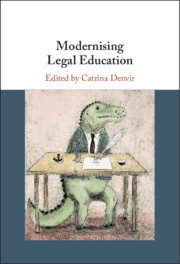Book contents
- Modernising Legal Education
- Modernising Legal Education
- Copyright page
- Contents
- Figures
- Tables
- About the Contributors
- Foreword
- Introduction
- 1 Do Lawyers Need to Learn to Code?
- 2 Experiential Legal Education
- 3 Skills Swap?
- 4 Scaling the Gap
- 5 Bringing ODR to the Legal Education Mainstream
- 6 Design Comes to the Law School
- 7 Developing ‘NextGen’ Lawyers through Project-Based Learning
- 8 Same As It Ever Was?
- 9 Ludic Legal Education from Cicero to Phoenix Wright
- 10 The Gamification of Written Problem Questions in Law
- 11 Virtually Teaching Ethics
- 12 Paths to Practice
- 13 ‘Complicitous and Contestatory’
- Afterword
- References
Introduction
Published online by Cambridge University Press: 30 December 2019
- Modernising Legal Education
- Modernising Legal Education
- Copyright page
- Contents
- Figures
- Tables
- About the Contributors
- Foreword
- Introduction
- 1 Do Lawyers Need to Learn to Code?
- 2 Experiential Legal Education
- 3 Skills Swap?
- 4 Scaling the Gap
- 5 Bringing ODR to the Legal Education Mainstream
- 6 Design Comes to the Law School
- 7 Developing ‘NextGen’ Lawyers through Project-Based Learning
- 8 Same As It Ever Was?
- 9 Ludic Legal Education from Cicero to Phoenix Wright
- 10 The Gamification of Written Problem Questions in Law
- 11 Virtually Teaching Ethics
- 12 Paths to Practice
- 13 ‘Complicitous and Contestatory’
- Afterword
- References
Summary
Once characterised as a relatively stable profession, unfettered by the influence of modernity and strongly resistant to external forces, the legal services sector has in recent years exhibited marked change. Efforts to preserve profit margins increasingly eroded by the introduction of new fee models, the demand for increased billing transparency, rising client expectations, the adoption of technology and heightened market competition from high volume legal process outsourcers, have all contributed to the sector’s evolution. In what has been viewed as a clear shift towards corporatisation and commercialisation, the legal profession in a number of jurisdictions has moved away from the broader social mission on which it was founded and in which it existed as ‘a branch of the administration of justice and not a mere money-getting trade’. Free market ideologies have undermined ‘justice and rights in the discourse of law’, and in its place, the generation of profit has become the primary indicator of success.
Keywords
- Type
- Chapter
- Information
- Modernising Legal Education , pp. 1 - 17Publisher: Cambridge University PressPrint publication year: 2020
References
- 1
- Cited by



